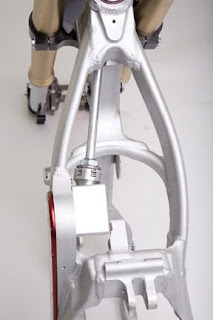THE BASICS OF AWD
Christini’s patented mechanical All Wheel Drive system delivers power from the motorcycle transmission to the front wheel through a series of chains and shafts. There is no energy-robbing hydraulics involved.
The lightweight all-mechanical system works similar to that of AWD systems found on four wheeled vehicles. The AWD system (powering the front wheel) is driven at a slightly lower rate than the rear wheel (approximately 80%). Under optimum traction conditions, the rear wheel is actually driving faster than the front AWD system. One-way clutches within the front hub allow the front wheel to freewheel under these conditions. At this point, the AWD system is effectively passive. Though the front AWD system is turning, it is not actually transferring power to the front wheel. When the rear wheel loses traction, the drive ratio, relative to your forward speed, changes. The AWD system engages, transferring power to the front wheel until traction is reestablished at the rear wheel.
The way the front system works is like pedaling a bicycle down hill. You are pedaling, but because of gravity (acting like the rear drive) the bike is traveling faster than you are delivering power. When you get to the bottom of the hill and slow down (similar to what happens when the rear wheel spins), you will begin to power the bike again.
An added benefit of AWD is that the front wheel does not want to wash out. When a front end tucks, the wheel stalls, stops turning, and begins to push. With the AWD system, as soon as the wheel begins to stall, power is delivered to the front wheel, forcing it to turn. With the front wheel under power, it is nearly impossible to wash out the front end.
HOW IT WORKS
Power runs via chain from the secondary countershaft sprocket up to a gearbox located on the frame.
Power is converted to a drive shaft running under the tank to the modified steering head.
Counter rotating bevel gears located within the head tube transfer power to the lower triple clamp
The lower triple clamp contains a small chain and sprocket system that drives two counter-rotating drive shafts.
The specially coated drive shafts are telescopic and incorporate linear ball spline bearings. They are counter rotating to eliminate torque effect. They run the length of the fork to the front hub.
The Christini AWD front hub is equipped with one-way clutches allowing the wheel to transfer power when needed, and freewheel when not in use.
ALL WHEEL DRIVE PERFORMANCE
All Wheel Drive has been proven to substantially enhance performance of off-road motorcycles even under the most demanding conditions. You can easily conquer the gnarliest hills, ruts, mud, roots, and logs that would cause havoc on a conventional motorcycle. The Christini AWD system also dramatically improves cornering and straight-line stability on all surfaces. The AWD system makes the motorcycle noticeably easier to ride and substantially reduces rider fatigue, allowing you to ride faster for longer periods of time. The AWD system can be turned on and off with a simple flip of the engagement switch. The mechanical Christini AWD system provides distinct advantages without compromising the performance of the motorcycle. Power that would otherwise be lost due to wheel spin is transferred immediately to the front wheel. The system adds just 15 lbs additional weight and has a power loss of less than 1/10th hp.
The Christini AWD system has been extensively race tested and has a proven track record of reliability in World Enduro, GNCC, Endurocross, Red Bull Last Man Standing, and Hare scrambles. The system is easily maintained and does not require any special tools.
ADVANTAGES OF A MECHANICAL ALL WHEEL DRIVE SYSTEM
- Increased traction and stability with no torque effect
- Improved cornering on all surfaces
- Only 15 lbs. added weight
- System uses less than 1/10th horsepower to operate
- Faster acceleration
- Unmatched hill climbing ability
- Easily serviced with no special tools required
- Reduced rider fatigue







No comments:
Post a Comment